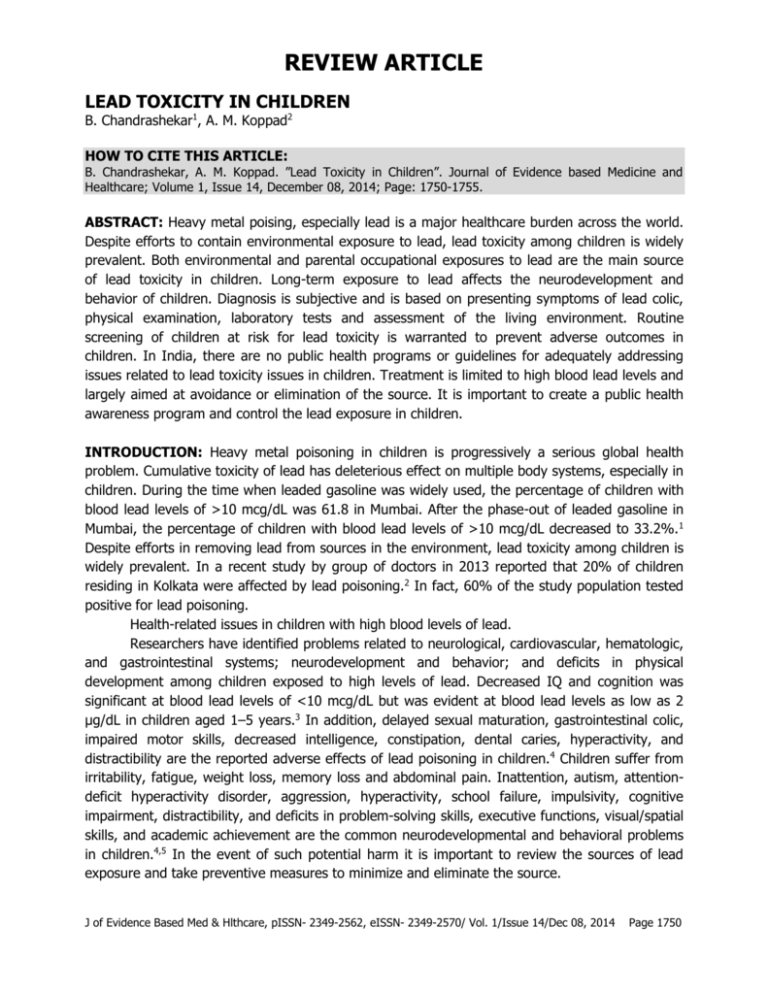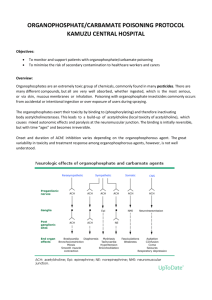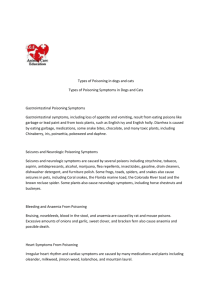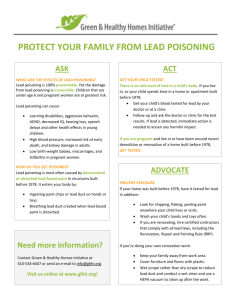lead toxicity in children - journal of evidence based medicine and
advertisement

REVIEW ARTICLE LEAD TOXICITY IN CHILDREN B. Chandrashekar1, A. M. Koppad2 HOW TO CITE THIS ARTICLE: B. Chandrashekar, A. M. Koppad. ”Lead Toxicity in Children”. Journal of Evidence based Medicine and Healthcare; Volume 1, Issue 14, December 08, 2014; Page: 1750-1755. ABSTRACT: Heavy metal poising, especially lead is a major healthcare burden across the world. Despite efforts to contain environmental exposure to lead, lead toxicity among children is widely prevalent. Both environmental and parental occupational exposures to lead are the main source of lead toxicity in children. Long-term exposure to lead affects the neurodevelopment and behavior of children. Diagnosis is subjective and is based on presenting symptoms of lead colic, physical examination, laboratory tests and assessment of the living environment. Routine screening of children at risk for lead toxicity is warranted to prevent adverse outcomes in children. In India, there are no public health programs or guidelines for adequately addressing issues related to lead toxicity issues in children. Treatment is limited to high blood lead levels and largely aimed at avoidance or elimination of the source. It is important to create a public health awareness program and control the lead exposure in children. INTRODUCTION: Heavy metal poisoning in children is progressively a serious global health problem. Cumulative toxicity of lead has deleterious effect on multiple body systems, especially in children. During the time when leaded gasoline was widely used, the percentage of children with blood lead levels of >10 mcg/dL was 61.8 in Mumbai. After the phase-out of leaded gasoline in Mumbai, the percentage of children with blood lead levels of >10 mcg/dL decreased to 33.2%.1 Despite efforts in removing lead from sources in the environment, lead toxicity among children is widely prevalent. In a recent study by group of doctors in 2013 reported that 20% of children residing in Kolkata were affected by lead poisoning.2 In fact, 60% of the study population tested positive for lead poisoning. Health-related issues in children with high blood levels of lead. Researchers have identified problems related to neurological, cardiovascular, hematologic, and gastrointestinal systems; neurodevelopment and behavior; and deficits in physical development among children exposed to high levels of lead. Decreased IQ and cognition was significant at blood lead levels of <10 mcg/dL but was evident at blood lead levels as low as 2 μg/dL in children aged 1–5 years.3 In addition, delayed sexual maturation, gastrointestinal colic, impaired motor skills, decreased intelligence, constipation, dental caries, hyperactivity, and distractibility are the reported adverse effects of lead poisoning in children.4 Children suffer from irritability, fatigue, weight loss, memory loss and abdominal pain. Inattention, autism, attentiondeficit hyperactivity disorder, aggression, hyperactivity, school failure, impulsivity, cognitive impairment, distractibility, and deficits in problem-solving skills, executive functions, visual/spatial skills, and academic achievement are the common neurodevelopmental and behavioral problems in children.4,5 In the event of such potential harm it is important to review the sources of lead exposure and take preventive measures to minimize and eliminate the source. J of Evidence Based Med & Hlthcare, pISSN- 2349-2562, eISSN- 2349-2570/ Vol. 1/Issue 14/Dec 08, 2014 Page 1750 REVIEW ARTICLE SOURCE AND FACTORS CONTRIBUTING TO LEAD TOXICITY: Ingestion and inhalation are the major routes of entry of lead into the body (Table 1).6 A host of source materials that contribute to toxic levels of lead blood include toys, cheap plastic mugs, lead pencils, cheap colors and crayons.2 Children of parents exposed to occupational lead hazard are also at risk of lead toxicity. Other source that have been identified to cause lead toxicity includes: air, drinking water, soil, dust, folk medicines, ayurvedics, and cosmetics; children's jewelry, lead-glazed ceramics, china, leaded crystal, pewter, imported candies or foods, imported food in cans; firearms with lead bullets, mini-blinds, and other common sources of lead such as car batteries, radiators, some inks, etc. In addition, wall paints, especially in older homes, old toys, furniture or crafts can also be source of serious lead toxicity.7 Route of entry in to body Ingestion Inhalation Surface contact (skin) Sources Toys; water pipes (lead pipes/corrosive pipes); lead in cans/ lead glazed ceramics; traditional medicines; Consumption of lead contaminated food. Industrial activities; burning of waste, leaded petrol; leaded paint Lead in cosmetics and traditional skin remedies Table 1: Sources of children’s exposure to lead Natural drinking water rarely carries lead in toxic levels. The materials used for storing water could be the main causative factor in contaminating the drinking water. Water supply systems assembled with lead-based solder (for join copper pipe, brass and chrome plated brass faucets) might leach lead into portable water.8 Currently, polyvinyl pipes are used for setting water connections within the houses and buildings and from main water connections. It is important to note that lead salts are used to stabilize polymers against degradation from heat, sunlight, and wear.9 In earlier days, household plumbing materials and water service line were made of metal pipes with high lead content that could leach in to the water supply. Soil carries fair amount of lead, especially in places where there is heavy vehicular traffic, industrial or mining areas. Children residing in such areas are at risk for lead poisoning. Outdoor air, especially in the industrial area can carry high level of lead. Living in the vicinity of industries engaged in manufacture of lead-acid battery, bronze foundries, rubber, plastics, and plants utilizing smelters, waste incinerators, utilities, etc. can cause lead accumulation in the body, especially in children.7 Potential workplace hazard relates to parents working in establishments that use leadbased products. They are at risk of carrying lead on their hair, skin, clothes, and shoes. Hobbies such as making pottery, stained glass perceived by parents or children, increase the risk of exposure to lead.7 Using lead containing ceramics, pottery, china, or crystal for serving or storing of food is another major source of lead toxicity in children.7 Some traditional cosmetics (surma, kohl) and medicines can also increase the risk for lead exposure.10 J of Evidence Based Med & Hlthcare, pISSN- 2349-2562, eISSN- 2349-2570/ Vol. 1/Issue 14/Dec 08, 2014 Page 1751 REVIEW ARTICLE Food contamination stems from sources such as soil, industrial pollution, agricultural technology, and food processing.11 In addition, candy, wrappers, pottery containers, and in certain ethnic foods also contain lead. Nutritional deficiencies such as iron, zinc, calcium, protein, and vitamin C deficiencies predisposes children to increased risk for enhanced absorption of ingested lead.3 SCREENING CHILDREN FOR LEAD TOXICITY: Routine screening for lead toxicity in children is neither practiced nor emphasized by any regulatory agencies in India. In the absence of a proper screening program in India, the prevalence of lead toxicity is under-estimated. Few researchers have conducted studies among school children to find the source of environmental lead exposure and easier methods to screen lead toxicity.12,13 Although no safe level of lead in blood in children, the Centers for Disease Control and Prevention (CDC) have issued a cut off value of not more than 5 mcg/dL.14 Since, studies have shown that lead-related deficits in intelligence was more significant at blood lead levels <10 μg/dL, the upper limit of lead was revised from not more than 10 mcg/dL to the current not more than 5 mcg/dL.3 DIAGNOSING LEAD POISONING: Lead poisoning is primarily a subclinical disease. Some of the clinical symptoms (Box 1) might be absent even at high blood lead levels.6 Abdominal pain, constipation, anemia and nonspecific neurological features related to dyslexia are often seen in children.2 A detailed probe into the growing environment and parents’ occupation might be key to prompt diagnosis of lead poisoning. Recognition of the lead colic syndrome (recurrent or intermittent abdominal pain, vomiting and constipation) is important in lead poisoning. Gastrointestinal symptoms tend to occur at lead blood levels of 20–50 mcg/dL and encephalopathy at levels more than100 µg/dL. It is largely accepted that venous blood sampling for estimating the blood levels are far more accurate than capillary blood because capillary blood sample carries the risk of contamination from the skin surfaces.15 D’Souza et al. compared the use of venous and capillary blood samples to assess the blood lead levels I children. They found a significant correlation between capillary and venous blood measurements and suggested that appropriate capillary sampling can be used as an alternative method to venous sampling for screening children for lead poisoning.12 Symptoms Gastrointestinal: Anorexia, nausea, vomiting, abdominal pain, constipation, metallic taste Central nervous system: Poor concentration, headache, fatigue, malaise, language and speech delay, behavioural problems, Physical examination Laboratory Elevated blood lead levels Signs of Hematology: Hypochromic intercranial anaemia, red blood cells with pressure, lead lines basophilic stippling, elevated in teeth, gout protoporphyrin levels (erythropoietic protoporphyria or Hypertension zinc protoporphyrin)* J of Evidence Based Med & Hlthcare, pISSN- 2349-2562, eISSN- 2349-2570/ Vol. 1/Issue 14/Dec 08, 2014 Page 1752 REVIEW ARTICLE encephalopathy: ataxia, seizure, coma Musculoskeletal: Muscle and joint pain (chronic) Hepatic injury: Elevated transaminase levels (acute poisoning) Other: Hyperuricemia, hypocalcemia Other chronic effects: Short stature, weight loss, weakness Urine: Proteinuria, glucosuria and aminoaciduria (acute poisoning) Radiological: Lead lines in the metaphyses of long bones (chronic poisoning). *Protoporphyrin levels (erythropoietic protoporphyria or zinc protoporphyrin) are usually not elevated until the blood lead level is ≥25 mcg/dL and may also be elevated in other conditions, such as iron deficiency anemia Box 1: Clinical presentation of lead poisoning MANAGEMENT OF LEAD TOXICITY IN CHILDREN: Although the most important treatment strategy is identification and elimination of major sources of lead exposure, the management and treatment of elevated lead levels in children is based on the blood lead levels.15,16 High levels: The CDC recommends chelation therapy (succimer, EDTA or dimercaprol) for blood lead levels ≥45 mcg/dL. Chelation may be instituted in consultation with a toxicologist. Before initiating therapy with chelation a series of tests are recommended.15,17 Children with levels higher than 70 mcg/dL require hospitalization and medication under direct medical supervision.15,17 Treatment with the chelating agent, succimer has been associated with reduction in blood lead levels, but without any detectable improvement in cognitive or behavioral function at 36 months of follow-up when children were in the age group of 5 or 7–7 ½ years old.16 MODERATE LEVELS: Chelation for blood lead levels ranging between 20 and 44 mcg/dL is not recommended because there were no measurable changes in neurologic, behavioral, and cognitive developmental outcomes.18,19 Moreover, a decrease in the rate of growth in height was seen in children treated with succimer compared to those receiving placebo.20 Environmental measures to prevent exposure to lead are necessary. LOW LEVELS: Children with blood lead levels less than 10 mcg/dL should be provided with basic nutritional supplements and parents should be educated about avoiding or eliminating environmental lead exposures.15 PREVENTING LEAD POISONING IN CHILDREN: Lack of awareness among parents and the society has to address adequately Children need to be protected from potential hazards of lead exposure. Routine screening of blood lead levels in children should be undertaken. It is important to educate parents on the sources and factors that effectively contribute to lead toxicity in J of Evidence Based Med & Hlthcare, pISSN- 2349-2562, eISSN- 2349-2570/ Vol. 1/Issue 14/Dec 08, 2014 Page 1753 REVIEW ARTICLE children. Parents should be counselled on primary prevention, wherein they are encouraged to find ways to avoid or eliminate sources that could possibly cause lead poisoning. Children deficient in certain micronutrients are at increased risk for lead poisoning and hence, steps to improve the nutritional status are important.15 CONCLUSION: Lead poisoning has serious healthcare impact on the overall development of the child. Lead toxicity in children is a serious healthcare problem, which needs to be addressed at the grassroots. Intake of lead can occur through ingestion, inhalation or skin contact. Most often, it is the environmental exposure that predisposes children lead poisoning. Lack of awareness among parents, the society, healthcare professionals, and government regulatory agencies is major hindrance for preventing lead toxicity in children. Treatment of lead poising is limited to high blood levels of 45 mcg/dL. Despite lowering blood lead levels with treatment or environmental control, reversal of neurological and developmental deficits is uncertain. A combined initiative from healthcare professionals, society and government is warranted to prevent control and prevent any further adverse impact on the future of our country. REFERENCES: 1. Nichani V, Li WI, Smith MA, et al. Blood lead levels in children after phase-out of leaded gasoline in Bombay, India. Sci Total Environ. 2006; 363 (1-3): 95-106. 2. Mitra P. Lead poisoning affects 20% Kolkata kids. The Times of India (India) 2013 July 14 [cited 2014 Dec 3] Available from http: //timesofindia.indiatimes.com/city/kolkata/Leadpoisoning-affects-20-Kolkata-kids/articleshow/21062303.cms 3. Jusko TA, Henderson CR, Lanphear BP, et al. Blood lead concentrations < 10 microg/dL and child intelligence at 6 years of age. Environ Health Perspect. 2008; 116 (2): 243-8. 4. Schnur J, John RM. Childhood lead poisoning and the new Centers for Disease Control and Prevention guidelines for lead exposure. J Am Assoc Nurse Pract. 2014; 26 (5): 238-47. 5. Grandjean P, Landrigan PJ. Neurobehavioural effects of developmental toxicity. Lancet Neurol. 2014 Mar; 13 (3): 330-8. 6. WHO. Childhood lead poisoning Available from http: //www.who.int/ceh/publications/leadguidance.pdf Accessed on December 4, 2014. 7. Department of health. Information for a healthy New York. Sources of Lead. Available from https: //www.health.ny.gov/environmental/lead/sources.htm Accessed on December 3, 2014. 8. Environmental protection agency. Consumer Factsheet on Lead in Drinking Water. Available from http: //water.epa.gov/lawsregs/rulesregs/sdwa/lcr/fs_consumer.cfm Accessed on December 3, 2014. 9. Levin R, Brown MJ, Kashtock ME, et al. Lead exposures in U.S. Children, 2008: implications for prevention. Environ Health Perspect. 2008; 116 (10): 1285-93. 10. WHO Fact sheet. Lead poisoning and health. Available from http: //www.who.int/mediacentre/factsheets/fs379/en/ Accessed on December 3, 2014. 11. D’souza HS, Dsouza SA, Menezes G, et al. Diagnosis, evaluation, and treatment of lead poisoning in general population. Indian J Clin Biochem. 2011; 26 (2): 197-201. J of Evidence Based Med & Hlthcare, pISSN- 2349-2562, eISSN- 2349-2570/ Vol. 1/Issue 14/Dec 08, 2014 Page 1754 REVIEW ARTICLE 12. D'Souza HS, Menezes G, Venkatesh T. Screening for lead poisoning in urban school children of southern India using capillary and venous blood samples Indian J Clin Biochem. 2002; 17 (1): 1-4. 13. Prashant V, Prashant A, Devanand D, et al. Screening of school children for blood lead levels and. attempts to reduce them by nonpharmacological means in a coastal city of India. Indian J Med Sci. 2008; 62 (5): 185-92. 14. Centers for Disease Control and Prevention. Blood lead levels in children Aged 1–5 Years — United States, 1999–2010. Morb Mortal Wkly Rep. 2013; 62 (13): 245-8. 15. Warniment C, Tsang K, Galazka SS. Lead poisoning in children. Am Fam Physician. 2010 Mar 15; 81 (6): 751-7. 16. McKay CA Jr. Role of chelation in the treatment of lead poisoning: discussion of the Treatment of Lead-Exposed Children Trial (TLC). J Med Toxicol. 2013; 9 (4): 339-43. 17. Centers for Disease Control and Prevention. Managing elevated blood lead levels among young children: Recommendations from the Advisory Committee on Childhood Lead Poisoning Prevention. Atlanta, Ga.: CDC; March 2002. http: //www.cdc.gov/nceh/lead/CaseManagement/caseManage_main.htm. Accessed December 4, 2014. 18. Rogan WJ, Dietrich KN, Ware JH, et al. The effect of chelation therapy with succimer on neuropsychological development in children exposed to lead. N Engl J Med. 2001 May 10; 344 (19): 1421-6. 19. Dietrich KN, Ware JH, Salganik M, et al. Effect of chelation therapy on the neuropsychological and behavioral development of lead-exposed children after school entry. Pediatrics. 2004; 114 (1): 19-26. 20. Peterson KE, Salganik M, Campbell C, et al. Effect of succimer on growth of preschool children with moderate blood lead levels. Environ Health Perspect. 2004; 112 (2): 233-7. AUTHORS: 1. B. Chandrashekar 2. A. M. Koppad PARTICULARS OF CONTRIBUTORS: 1. Assistant Professor, Department of Paediatrics, SIMS, Shimoga. 2. Professor, Department of Paediatrics, SIMS, Shimoga. NAME ADDRESS EMAIL ID OF THE CORRESPONDING AUTHOR: Dr. B. Chandrashekar, Assistant Professor, Department of Paediatrics, SIMS, Shimoga. E-mail: drchandrashekarb2007@yahoo.com Date Date Date Date of of of of Submission: 29/11/2014. Peer Review: 30/11/2014. Acceptance: 03/12/2014. Publishing: 04/12/2014. J of Evidence Based Med & Hlthcare, pISSN- 2349-2562, eISSN- 2349-2570/ Vol. 1/Issue 14/Dec 08, 2014 Page 1755




